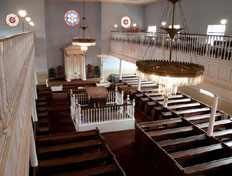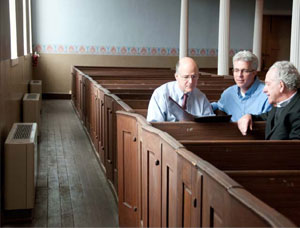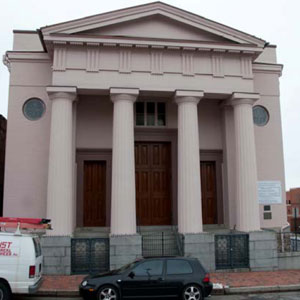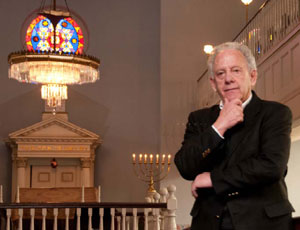Daikin's Energy Efficient Heat Pumps Satisfy Preservationists' Guidelines at the Historic Lloyd Street Synagogue
 A top-down view of the interior of the Lloyd Street Synagogue, the oldest synagogue in maryland, disclosed no evidence of the new
A top-down view of the interior of the Lloyd Street Synagogue, the oldest synagogue in maryland, disclosed no evidence of the new With the Maryland Historical Trust keeping a very sharp eye on the restoration of the nation’s third oldest synagogue, the trustees, the general contractor, and the architect knew every choice they made would be under intense scrutiny. “From the footing to the roof’s ridgeline, nothing was exempt from the agency’s review and approval,” said Jewish Museum of Maryland trustee Lee Rosenberg about big changes at the Lloyd Street Synagogue, built in 1845.
Near the top of the list of renovations that could have negatively impacted the aesthetics of the historic structure was the installation of an air conditioning system for the first time in the synagogue’s 155-year history. Choosing a system that would preserve the synagogue’s character and beauty while delivering year-round comfort was of paramount concern to the project team.

Daikin Sales Engineer Michael Panopoulos (left), John Lederer of Frosty Refrigeration, and Lee Rosenberg (right), a trustee with the Jewish Museum of Maryland, confer on the performance of the new Daikin VRVIII heat pump system. The Daikin FXLQ floor console models are seen at left, flushed on the wall below the windows.
“The Daikin FXLQ floor console models fit neatly under the low historic synagogue windows... These console units rest flush against the wall and are actually less obtrusive than the radiators that had previously been there.”
John Lederer ,
Frosty Refrigeration Inc.
In the end, the team chose an intelligent energy-efficient Variable Refrigerant Volume® (VRV) comfort system by Daikin to deliver both heating and cooling with advanced zoning capabilities. The new equipment, however, remains virtually unnoticeable to synagogue visitors. “There is no evidence that any changes have been made,” said Rosenberg. “Even someone who has been there 50 times would not notice the change. But in the warmer
weather, especially, they certainly will feel a lot more comfortable than they did in the past.”
The Jewish Museum of Maryland selected the Daikin VRVIII heat pump system for the two-story Greek Revival style synagogue after a very careful search of all of its options. In place, was a boiler/hot water radiator system for cold weather, and no cooling system at all for warm weather. Initially, the team looked into conventional comfort systems that would have required installing – and trying to hide – ductwork in the historic space. “This would have involved creative placement of duct work and probably having to alter the space to accommodate it,” said John Lederer, principal owner of Frosty Refrigeration Inc., the general contractor for the entire renovation and restoration of the project.
A Rich Religious Heritage

The Greek Revival style Lloyd Street Synagogue, built in 1845, was the first synagogue erected in Maryland. In 1861, the synagogue was expanded but kept the architect's original classical style in the sanctuary and exterior façade. In 1889, the structure became the home of St. John the Baptist Roman Catholic Church, one of the first Lithuanian parishes in the U.S. It changed hands once again in 1905, when it became the home for Somrei Mishmeres HaKodesh, an Orthodox congregation. Recent archaeological discoveries include the original 1845 mikveh, or ritual bath, on the lower level of the synagogue.
The Lloyd Street Synagogue, listed on the National Register of Historic Places, is under the aegis of the Jewish Museum of Maryland. For more information, visit www.jewishmuseummd.org.
Early in the project, the engineering firm of JMT Inc., working with HVAC equipment supplier Havtech Corp., proposed a Daikin duct-free system be considered as the best choice for the heating and cooling system for a number of reasons, including aesthetics, space, and energy efficiency. When the museum owners decided to go with a design-build approach to the project, Frosty Refrigeration took complete responsibility for the HVAC system design and installation. Lederer and preservation architect John R. Srygley, AIA, of JRS Architects Inc. eventually decided to stay with JMT’s recommendation and worked very closely with Daikin on the final system design.
Thos. Somerville Inc., a wholesale HVAC equipment supplier, delivered the product to Frosty for the project. “After we reviewed and rejected all of our options, we came back to the Daikin solution,” noted Srygley, “because of the fact that it both heats and cools, and also provides a streamlined alternative for a historic preservation solution.”
Less Obtrusive Than Old Radiators

"From the footing to the roof’s ridgeline, nothing was exempt from the agency’s review and approval,” said Jewish Museum of Maryland trustee Lee Rosenberg (pictured)
The new comfort system consists of two twinned 10-ton outdoor VRVIII condensing units supplying 20 tons of capacity to the upper level of the space, plus another unit supplying 8 tons of capacity to the lower level, and 21 one-ton and two-ton floor console models lining the interior walls of both floors to serve as supply and return air units. The configuration of both inside and outside units was the optimum solution for the space limitations of the mid-19th century building, according to Lederer. “The Daikin FXLQ floor console models fit neatly under the low historic synagogue windows,” he said. “They enabled us to maintain the aesthetics of the structure with minimal disruption. These console units rest flush against the wall and are actually less obtrusive than the radiators that had previously been there,” Lederer said.
The three outdoor condensing units that provide a total of 28 tons of capacity also provided a preservation solution to the team. They are “tucked away” in a narrow alley right behind the building -- another plus for the renovation and restoration goal of the synagogue. “Several of the HVAC alternatives we were looking at would have required placing the outdoor equipment on our roof, which really would have been contrary to what the historic preservationists would have been willing to accept,” noted Lederer.
Since the system was commissioned in the fall of 2009, the operation of the Daikin system has been impressive, according to Lederer. “It’s been above our expectations, there’s no doubt about it. The heat production, even in freezing weather, as well as the acoustical performance, have been just tremendous,” he said. “The balance of air conditioning in the summer in every corner of the synagogue has been remarkable, as well.”
John Lederer,
Frosty Refrigeration Inc.
Lederer pointed out that each individual Daikin console has a built-in intelligent return air sensor helping vary the flow of refrigerant to provide increased comfort exactly where and when it’s needed. “It acts independently in its own little zone,” he said. For example, when the sun streams in south-facing windows, the units can run at higher capacity than those on the opposite side, where the space is cooler. In addition, multiple consoles on each floor are controlled by a centralized intelligent seven-day programmable controller, which gives the synagogue overall control of the comfort of the space.
One other feature of the Daikin system helped the Lloyd Street Synagogue design/build team make its choice. “Because of the location of our synagogue, which is very close to Baltimore’s Inner Harbor and very close to sea level, we had to contend with moisture concerns. After doing a thorough study, we knew that the Daikin system control logic would help manage the discomfort due to high humidity levels better than standard on/off systems. We are very sure we are meeting the very stringent requirements for moisture, humidity, and temperature that are always a concern in a museum setting,” museum trustee Rosenberg observed. “We are pleased we made the best possible choice for our historic synagogue, the oldest in the state of Maryland.”
Read more success stories:
- Historic Lloyd Street Synagogue, Maryland
- Post Falls Periodontists(PDF)
- Western Extralite(PDF)
- Dallas-Fort Worth Area School District
- University of Hawaii at Manoa
- Meadows at Oldwick - a study of an assisted living facility for people with disabilities
- ASHRAE Headquarters renovation
- Warwick House of Hope
- Hoosick Valley Church
- New Skyscraper Construction
- Office Building Retrofit
- Historical Hotel Upgrade
- Hilton Hotel in Manchester, UK (VRV-WII case study)

